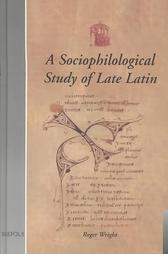A Sociophilological Study of Late Latin [Literature & Philology]

Roger Wright
A Sociophilological Study of Late Latin(Utrecht Studies in Medievla Lieteracy 10).
Tunrhout: Brepols, 2002, 389 p.
This book
Section A: Late Latin, medieval Latin and Romance
1. How Latin came to be a foreign languages for all
2. Why the Romance languages are not all the same
3. Periodization
4. Viva voce
Section B: Texts and language in late antiquity
5. The role of Priscian
6. The Latin-Romance "ensemble" of the seventh century
7. Foreigner's Latin and Romance: Boniface and Pope Gregory II
8. Rhythmic poetry and the author's vernacular
Section C: The ninth century
9. Alcuin's de orthographia and the council of Tours(A.D. 813)
10. The relative chronology of new scripta and new languages
11. The end of written laudatio in Al-Andalus
12. Early medieval pan-Romance comprehension
Section D: Italy and Spain in the tenth and eleventh centuries
13. Periodization and language names: Italo-Romance in 1000 A.D.
14. The glossaries of tenth-century Spain:(1)the 1997 edition of códece emilianense 46
15. The glossaries of tenth-century Spain:(2)Romance vocabulary in the San Millán glossaries
16. In what language are the glosses of San Millán and Silos ?
Section E: Twelfth- and thirteenth-century Spain
17. Sociophilology and twelfth-century Spain
18. The assertion of Ibero-Romance
19. Why Judeo-Spanish was called "ladino"
20. A sociopholological approach to the earliest Romance texts:[-t], -/t/ and -t in Castile(1206-1208)
Section F: Sociophilology and historical linguistics
21. Comparative, structural and sociolonguisitic analyses of the history of the Romance languages
22. Writing: photo or disguise ?
23. Textual evidence for language change
24. What actually changes durign a 'sound change' ?
25. Conclusion
Bibliography
Index
* * * * * * * * * *
「社会文献学」とは見慣れぬ述語だが、収録論文を読む限り、文献学知を社会言語学の枠組みで解釈しなおしたものである。歴史家にはとっつきやすい、というか、こうでもしてくれないと、それぞれが別の学問となってしまった歴史家と文献学者が対話することは難しい。
著者は現在リヴァプール大学でスペイン語の正教授として教鞭をとる。古代末期から中世盛期のラテン語ならびにその派生語であるロマンス諸語を専門とする。本書は多産な著者による論文の選集であり、中心を占めるのはイベリア半島のテクストだが、もう少し一般的な内容のものも含まれている。私が著者の名前を知ったのは、
Roger Wright, Late Latin and Early Romance in Spain and Carolingian France. Liverpool: F. Cairns, 1982, xii+322 p.
である。現物を見たことはないが、おそらくこれが彼の学位論文である。その後、
Roger Wright(ed.), Latin and the Romance languages in the early Middle Ages(Romance linguistics). London &New York: Routledge, 1991, ix+262 p.
という論集の編纂をしている。この中にはR・マッキッタリックを含めて、いくつかの歴史家の寄稿もある。初期中世はラテン語からロマンス語への以降という大問題を抱えているので、古くはフェルディナン・ロト以来、歴史家がその力量を見せる分野でもあった。
歴史言語学者による同様の試みとして、
Michel Banniard, Viva voce: communication écrite et communication orale du IVe au IXe siècle en Occident latin(Collection des études augustiniennes; Série moyen-age et temps modernes 25). Paris: Institut des études augustiniennes, 1992, 596 p.
がある。初期中世のコミュニケーション研究にとっては基本書であるが、言語学者のものだけに言語学の基礎知識も必要となり、一般史家が簡単に理解できる内容とはなっていない。たとえばこんな具合に。しかし、その考えのエッセンスは、彼の手による、ささやかではあるが奥深い初期中世の通史にも反映されている。
Michel Banniard, Genèse culturelle de l'Europe: Ve-VIIIe siècle, préface de Pierre Bonnassie. Paris: Seuil, 1989, 254 p.
Id., Le Moyen Age occidental(Que sais-je ? 1807). Paris: PUF, 3 ed., 1991, 128 p.
中世史家はテクストを扱う以上、言語学の動向には敏感でなければならないはずである。しかし日本ではその橋渡しの役割を担う研究者があまりにも少ない。私の知る限り、実践知の紹介として、
佐藤彰一「識字文化・言語・コミュニケーション」佐藤彰一他編 『西欧中世史(上) 継承と創造』(ミネルヴァ書房 1995)
が、「固有名詞」という狭い分野ではあるが、研究道程の紹介として、
千葉敏之「固有名詞学」『西洋中世学入門』(東京大学出版会 2006), 131-53頁
がある程度である。もちろん、言語学の立場からのアプローチもあるはずだが、私は寡聞にして知らない。

